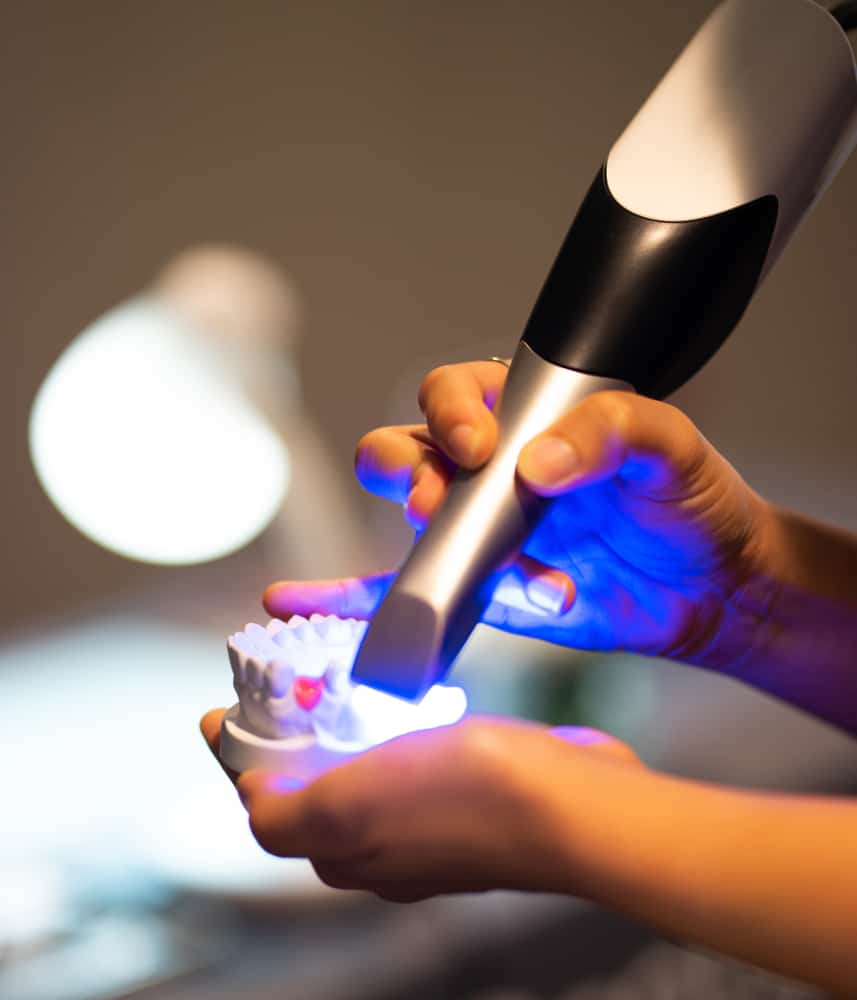What is the Procedure of Recording the Digital Dental Impression?
The dentist or dental assistant uses a digital impression device to capture tooth/teeth preparation pictures. When the area to be handled has been anesthetized, and clear of blood and saliva, the teeth are lightly dusted with specially formulated titanium dioxide powder to scan both arches and the bite. Other systems (for example, Cadent iTero and the impression technology that comes with the E4D Dentist System for in-office CAD/CAM restorations) allow dentists to produce a powder-free, 3D picture of the patient’s teeth.
An intraoral wand is usually used to collect the digital impression, which is inserted into the patient’s mouth and passed over the surface region of the tooth or teeth. A chairside monitor is typically used in digital impression systems to view the impression image as it is recorded.
Furthermore, most digital impression systems rely on point-and-click capture, which necessitates the assembly of images to produce the final digital impression. On the other hand, the Lava C.O.S method is the only one that employs three-dimensional real-time video capture to view live images on a touch-screen monitor. This live video capture generates the final digital experiences without the need for data manipulation.
When reviewing the real-time electronic image, the dentist will enlarge and manipulate it for greater detail. Your dentist will ensure that any potential errors are detected and corrected on screen before submitting the digital impression electronically to the dental laboratory or in-office dental CAD/CAM system. The distribution workflow can differ depending on the automated impression method used by the dental practice. Current digital impression systems for dental offices are either digital impressions only or digital chairside CAD/CAM systems.
Cadent iTero, 3M ESPE Lava Chairside Oral Scanner (C.O.S.), and Sirona CEREC Connect digital impression systems digitally record the tooth preparations and adjacent teeth in the arch or quadrant as opposing teeth and bite registration. The data is electronically transmitted to the dental laboratory for use in restoration fabrication.
Digital chairside devices, such as the D4D Technologies E4D Dentist System and the Sirona CEREC Acquisition Center (A.C.), also take digital impressions. Still, the data is used inside the dental office to plan, mill, and produce the final restoration in a single appointment for same-day dentistry.
How Long Does Digital Dental Impression Take?
A digital impression of prepared teeth takes about a minute and a half to capture. It only takes 45 seconds to record an impression of the teeth in the opposite arch.
Who Records the Digital Dental Impression?
Trained dentists or dental assistants may record digital impressions. Manufacturers of digital impression systems usually provide 2 to 3 days of in-office training for installation, integration, certification, and additional offsite training at established training locations.
Are Digital Dental Impressions Expensive?
After the initial investment of about $21,000 to $24,000 for equipment and training – digital scanning systems offer considerable cost savings to dental practices. They significantly reduce the need for conventional impression products, which typically cost about $30 per impression. There are no mailing costs because files are submitted electronically; the higher accuracy and ease of digital scanning mean less or no required changes or remakes, representing additional savings in time, quality, and material and labor costs.
If smile restoration is not for cosmetic purposes, the expense of digital impressions is covered by specific dental insurance policies or out-of-pocket deduction schemes. For information on your situation, contact your insurer and your dental office.
Looking for the best dental implants in Arlington, TN?
Dr. Adatrow can help!
If you have any further questions about oral health, you can schedule a consultation with Dr. Adatrow. Dr. Adatrow has more than 18 years of experience in placing dental implants, with a success rate of over 97%, and can provide you with the best possible dental treatment. He is a Board-Certified Prosthodontist and Periodontist. Please contact our office to schedule your consultation now!

